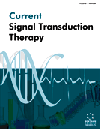- Home
- A-Z Publications
- Current Signal Transduction Therapy
- Previous Issues
- Volume 17, Issue 3, 2022
Current Signal Transduction Therapy - Volume 17, Issue 3, 2022
Volume 17, Issue 3, 2022
-
-
ECG for Cardiovascular Diseases Using Soft Computing Algorithms
More LessAuthors: Prerak Mathur, Tanu Sharma and Karan VeerElectrocardiogram (ECG) is widely used in the healthcare domain because of its usage as a diagnostics tool for several cardiovascular diseases. It becomes essential to study and analyse the ECG data with the help of classification techniques. In this review paper, a brief overview of ECG signal information is presented. Various approaches for diagnosing cardiovascular diseases have been discussed, along with the need for accu Read More
-
-
-
Age Related Osteoarthritis: Regenerative Therapy, Synthetic Drugs, and Naturopathy to Combat Abnormal Signal Transduction
More LessAuthors: Tamanna Ahmed, Rishita Dey, Jhumpa Mukherjee, Asmita Samadder and Sisir NandiIntroduction: Osteoarthritis (OA) is a common chronic inflammatory neurodegenerative joint disorder that causes disability among the geriatric population. It involves the loss of the articular cartilage that covers the end of a long bone thereby failing to prevent the friction between the joints. Methods: The literature on the prevalence of OA and different risk factors like physical inactivity, obesity, and joint injury was searched t Read More
-
-
-
A Non-Invasive IoT-Based Glucose Level Monitoring System
More LessAuthors: Sudip Paul, Shruti Jain, Bikram Majhi, Karobi Pegu and Vinayak MajhiBackground: Diabetes is one of the most common diseases and is a major public health problem worldwide. It is also the leading high-risk cause of death and disability in the world. To avoid further complications due to diabetes, regular monitoring of blood glucose levels is very important. All the current methods used to measure blood glucose are invasive, which require finger piercing, and this invasive method is more painful an Read More
-
-
-
Computational Model for Prediction of Foxo Protein Employing Ensemble Learning Algorithm
More LessBy Shruti JainAims: In this paper, Forkhead box O (FOXO) protein using the ensemble learning algorithm is predicted. When FOXO is in excess in the human body, it leads to LNCap prostate cancer cells, and if deficit leading neurodegenerative diseases. Objective: Neurodegenerative diseases, like Alzheimer's and Parkinson's, are neurological illnesses that are caused by damaged brain cells. For prediction of FOXO protein, Gradient Boosted Ma Read More
-
-
-
Effect of Grid Search and Hyper Parameter Tuned Pipeline with Various Classifiers and PCA for Breast Cancer Detection
More LessAuthors: Sushovan Chaudhury, Nilesh Shelke, Zahraa M. Rashid and Kartik SauBackground: The study of breast cancer detection begins with the WBCD dataset for most researchers, as it is a very well-known dataset. We use this dataset as a benchmark in this paper to study ML algorithms like SVM, DT, RF, KNN, NB classifiers, Logistic Regression, Extra Trees, Bagging Classifiers with hard and soft voting, Ensemble techniques and Extreme Gradient Boosting classifiers like XG Boost and 2 deep learning Read More
-
-
-
Evaluation of Fetal Head Circumference (HC) and Biparietal Diameter (BPD (Biparietal Diameter)) in Ultrasound Images Using Multi-Task Deep Convolutional Neural Network
More LessAuthors: Fathimuthu Joharah and Kother MohideenIntroduction: Ultrasound imaging is a standard examination during pregnancy that can measure specific biometric parameters towards prenatal diagnosis and estimating gestational age. Fetal head circumference (HC) is a significant factor in determining fetus growth and health. Methods: This paper proposes a multi-task deep convolutional neural network for automatic segmentation and estimation of HC (Fetal head circu Read More
-
-
-
Digitization of Prior Authorization in Healthcare Management Using Machine Learning
More LessBackground: Prior Authorization is a widely used process by health insurance companies in the United States before they agree to cover prescribed medication under medical insurance. However, the traditional approach includes long-length papers, leading to patients' delayed processing of their claims. This delay may deteriorate the patient’s medical condition. Also, due to man-made errors, there is a chance of incorrect de Read More
-
Volumes & issues
-
Volume 20 (2025)
-
Volume 19 (2024)
-
Volume 18 (2023)
-
Volume 17 (2022)
-
Volume 16 (2021)
-
Volume 15 (2020)
-
Volume 14 (2019)
-
Volume 13 (2018)
-
Volume 12 (2017)
-
Volume 11 (2016)
-
Volume 10 (2015)
-
Volume 9 (2014)
-
Volume 8 (2013)
-
Volume 7 (2012)
-
Volume 6 (2011)
-
Volume 5 (2010)
-
Volume 4 (2009)
-
Volume 3 (2008)
-
Volume 2 (2007)
-
Volume 1 (2006)
Most Read This Month
Article
content/journals/cst
Journal
10
5
false
en


